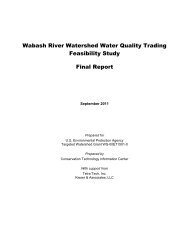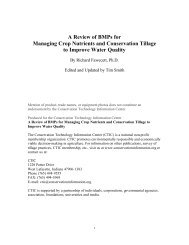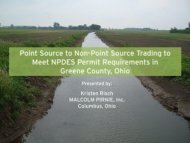Facilitating Conservation Farming Practices and Enhancing ...
Facilitating Conservation Farming Practices and Enhancing ...
Facilitating Conservation Farming Practices and Enhancing ...
You also want an ePaper? Increase the reach of your titles
YUMPU automatically turns print PDFs into web optimized ePapers that Google loves.
<strong>Conservation</strong> tillage has a very direct effect on the rate at which<br />
atmospheric carbon is sequestered in cropl<strong>and</strong> soils. In an Indiana<br />
study, intensive tillage stored 0.042 tons (84 pounds) of carbon per<br />
acre, moderate tillage sequestered 0.169 tons (338 pounds) per acre,<br />
<strong>and</strong> no-till stored 0.223 tons (446 pounds) of carbon per acre annually<br />
(Smith et al., 2002). According to Feng et al. (2000), conservation tillage<br />
<strong>and</strong> residue management could account for 49 percent of the carbon<br />
sequestration potential of U.S. cropl<strong>and</strong>. Switching from conventional<br />
tillage to no-till in a corn-soybean rotation in Iowa has been estimated to<br />
increase carbon sequestration by 550 kg/ha (485 lb/a) per year (Paustian<br />
et al., 2000).<br />
The power of no-till to build soil organic matter <strong>and</strong> sequester carbon<br />
was documented by Reicosky <strong>and</strong> Lindstrom (1995), who measured<br />
that a single pass with a moldboard plow in a field of wheat stubble<br />
released five times as much carbon dioxide over 19 days as was<br />
released from untilled plots.<br />
Because even a single tillage pass can aerate the soil <strong>and</strong> stimulate<br />
microbial activity that returns a significant amount of the soil organic<br />
carbon to the atmosphere as CO 2 , continuous no-till – maintaining notill<br />
practices throughout the crop rotation – is the most effective way<br />
to maximizing the carbon sequestration potential of the soil. Using a<br />
conservative assumption that an acre of continuously no-tilled cropl<strong>and</strong><br />
sequesters 0.6 metric tons of carbon dioxide equivalent (the st<strong>and</strong>ard<br />
measure of carbon sequestration) per acre per year, it is estimated the<br />
16.3 million acres of continuously no-tilled cropl<strong>and</strong> in the U.S. is currently<br />
sequestering 9.7 million tons of carbon dioxide equivalent each<br />
year (CTIC, 2009).<br />
Reduced emissions. <strong>Conservation</strong> tillage has an even more direct<br />
impact on greenhouse gas levels. It can reduce the number of trips<br />
needed to produce a crop <strong>and</strong> lowering the horsepower requirement for<br />
crop production, it reduces the amount of fuel used in farming. Mulch<br />
tillage – light to moderate tillage passes that leave more than 30 percent<br />
residue cover after planting – saves approximately 2.0 gallons per acre<br />
(Jasa et al., 2000). Across the 46.7 million acres of mulch-tilled cropl<strong>and</strong>,<br />
that represents a savings of 93.4 million gallons of diesel. Jasa<br />
et al. (1991) figured the advantage of no-till over moldboard plowing<br />
Soybeans:<br />
Valuable Rotation Crop<br />
Technology that encourages the<br />
use of soybeans in a crop rotation<br />
provides growers with a powerful<br />
tool for improving yields <strong>and</strong> managing<br />
pests. Beyond their ability<br />
to fix atmospheric nitrogen in the<br />
soil, soybeans can also enhance the<br />
yield of subsequent crops by leaving<br />
soil moisture in place for the following<br />
crop, interrupting pest <strong>and</strong><br />
disease cycles, supplying chemical<br />
compounds that may enhance the<br />
health or growth of other crops, <strong>and</strong><br />
improving the microbial community<br />
in the soil (Swink et al., 2007).<br />
13








